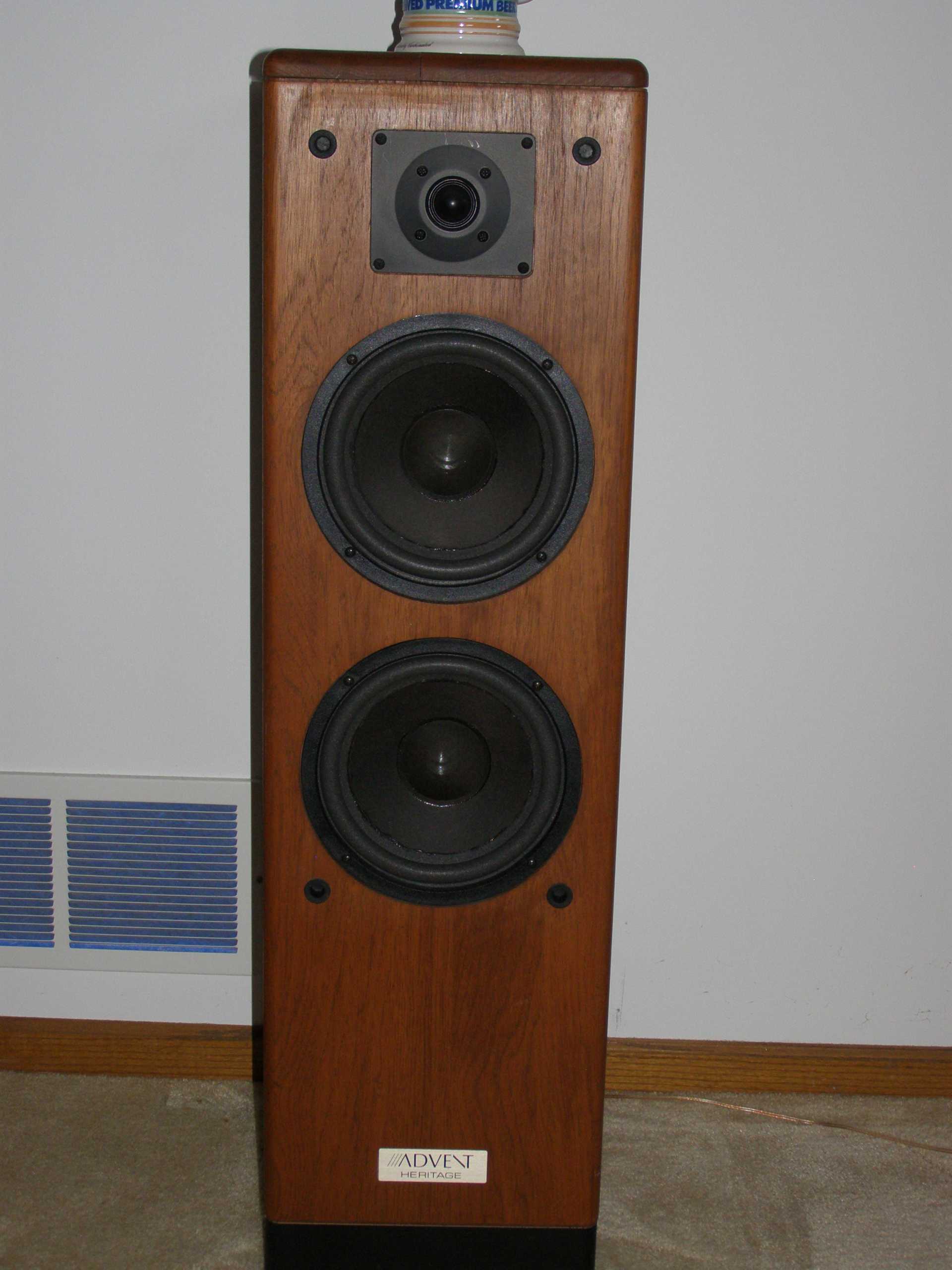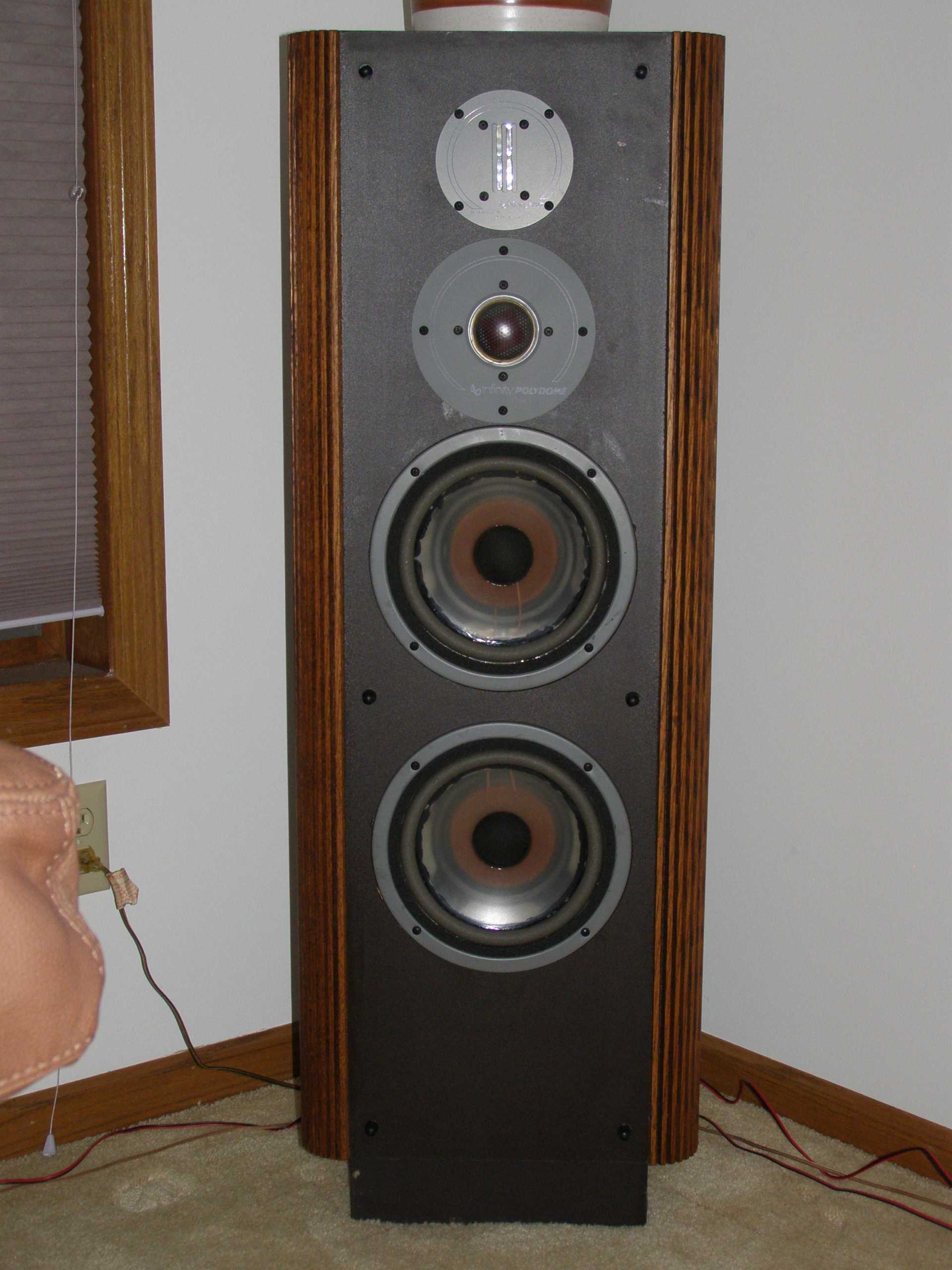I am pleased to report that I have experienced complete and utter success in my efforts (Woot!!)
Here's a how-to (how I did it) for anyone looking to try this in the future. It's pretty straight forward when you get into it but the key is to be patient and take your time to allow full glue curing between steps when necessary.
Typical disclaimer:
I am showing what I did for the general benifet of others. What you do do or need to do may very well be different that what I've shown here. This is a simple guideline. As usual your mileage may vary and follow it at your own risk

Now with that out of the way...
Prep: Remove the sub from the enclosure. There are write-ups on this so I didn't take photos of every step here. Basically you need nothing except for the driver itself on your work bench.
Step 1:
Confirm that it's only the foam surround that's damaged. Carefully inspect the spider, tinsel leads and cone for wear, tear and cracks. If you find any other damage you may need other repairs, or replacement may be a better option. Also evenly push on the cone, gently but firmly, to exercise the speaker. If you feel any friction, grinding or hear any scraping the cone is out of alignment or the coil is damaged. It could be possible to re-align the cone, but a damaged coil will pretty much mean its time for a new speaker. I had no friction or sounds at all, so I did not have to go through the alignment process.
This is the extend of my speaker's damage. I used 3 fingers evenly on the cone to move it and all was well, so onward I went.
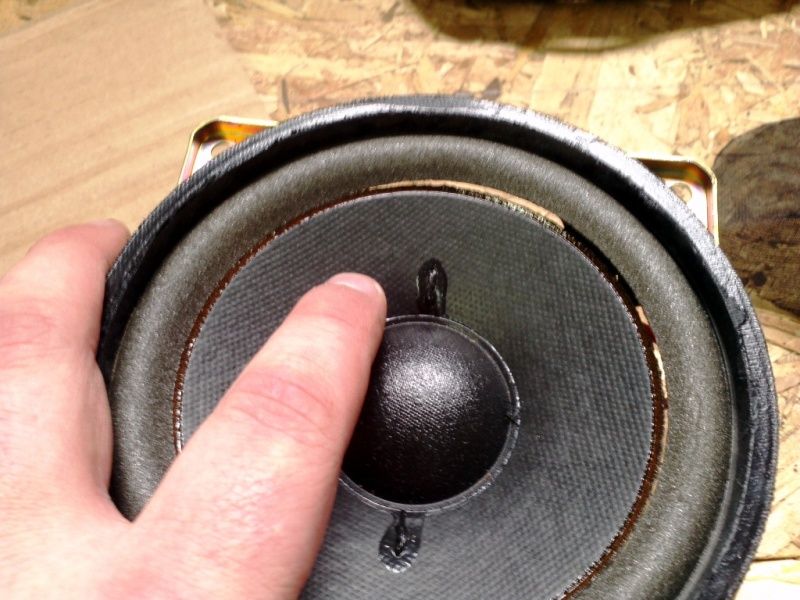
Step 2:
Gather your materials and tools. I used the following at various points of the repair: flat screwdriver, utility knife (with sharp blade), small/cheap paint brush, Elmer's white glue, rubbing alcohol, a cotton swab, a couple of q-tips, and the new foam surround.
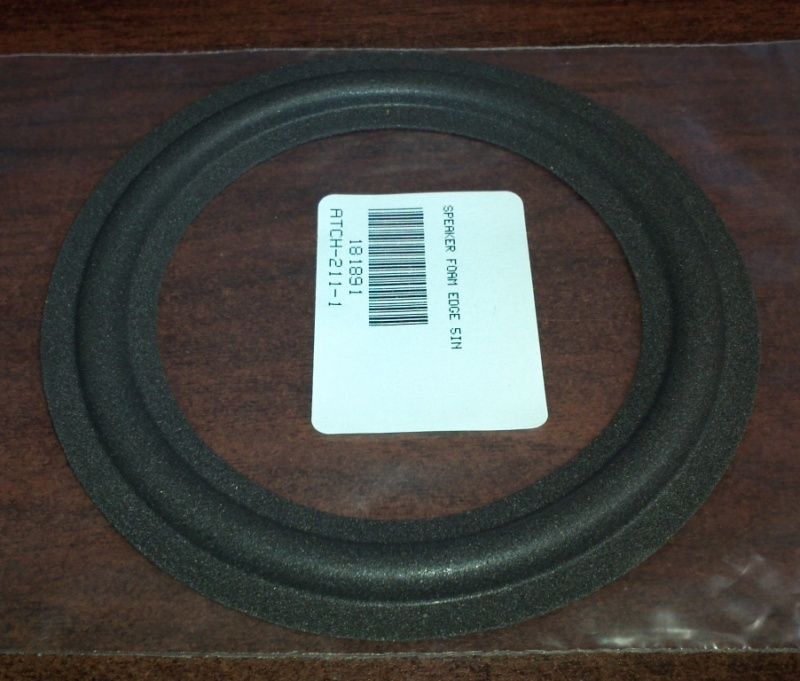
Step 3:
I had cut off the OEM cloth grill over the speaker to inspect the foam. There is no way to re-use this if you do so, but it is not super critical anyways. If there is any part of the surround still attached to the speaker cone carefully and precisely cut it as close to the cone as possible with your sharp knife. Next is to carefully remove the plastic ring on the top of the speaker frame. Go slow, the ring is glued on top of the foam surround and it will likely tear some foam with it, this is why you want to cut the foam away from the cone first. I started in one corner with the least amount of visible glue and pried up with a flat screwdriver. Once it starts to come up work your way around until you have the whole thing loose and set it aside. Don't break this piece, it is critical to re-use it.
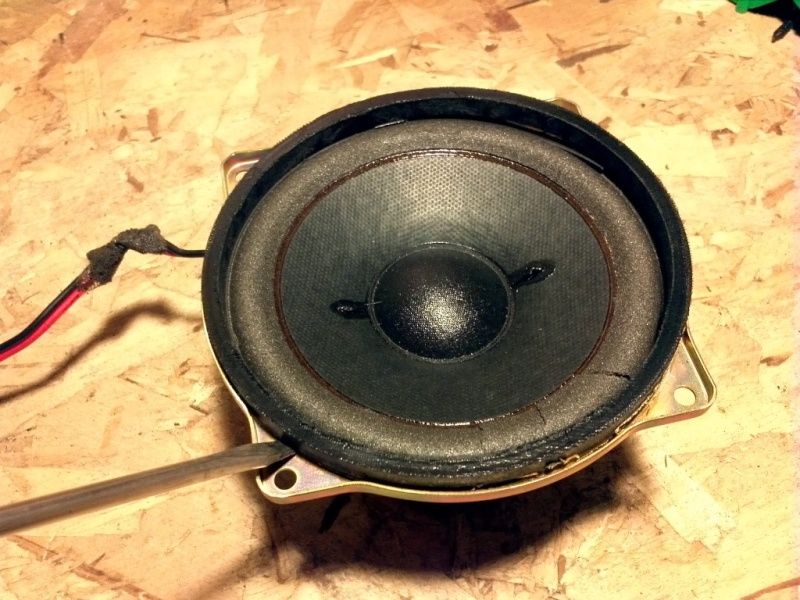
Step 4:
Clean the speaker frame of all residual foam surround bits. Having a little glue left behind is ok, but you need all of that old foam off of there. I used the flat screwdriver again, and scraped the outside frame in a clockwise direction. I'm right handed and this was the most comfortable for me, it also kept the pressure of the screwdriver to the outside of the frame so if it did happen to slip it went away from the speaker instead of into the cone.
This photo show 3/4 of the frame scraped, and a bit of the old stuff left to try and show what you need to remove.
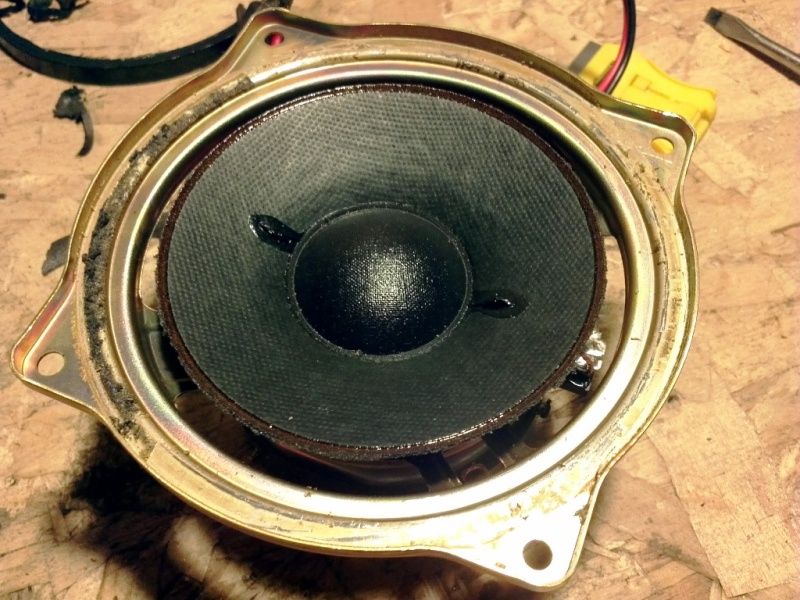
Step 5:
Bust out that rubbing alcohol and cotton swab. With the frame fully scraped wipe it down with a bit of alcohol. This will help remove some of that old glue, and really clean it for a good mating surface between the new surround and existing frame.
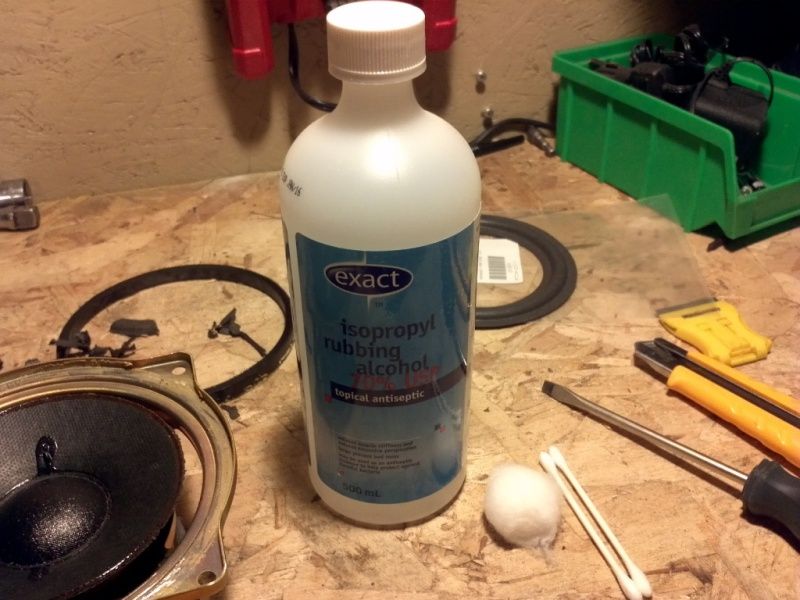
All cleaned up with the old foam off:
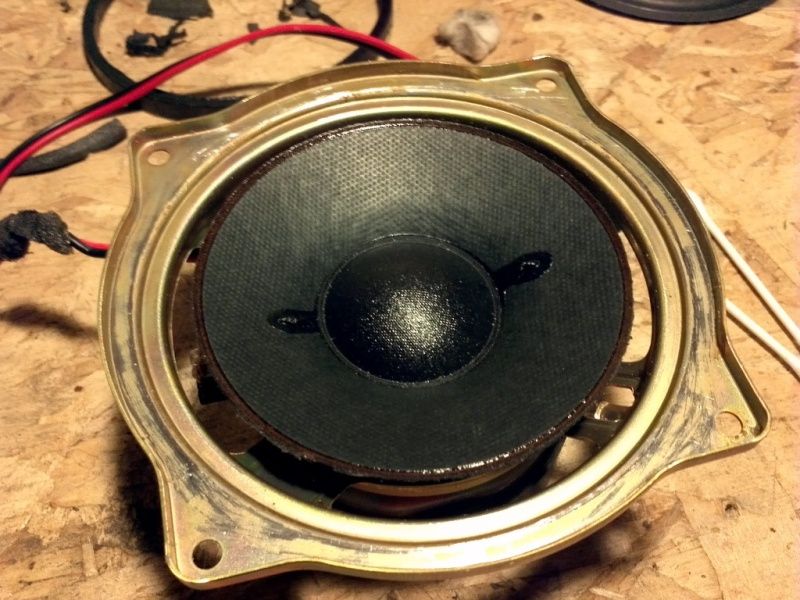
Step 6:
Test fit the new srround dry! If it doesn't fit right now is the time to trim/modify it or find another one that fits better. The one I had found locally happened to be a near perfect fit and required no modifications at all.
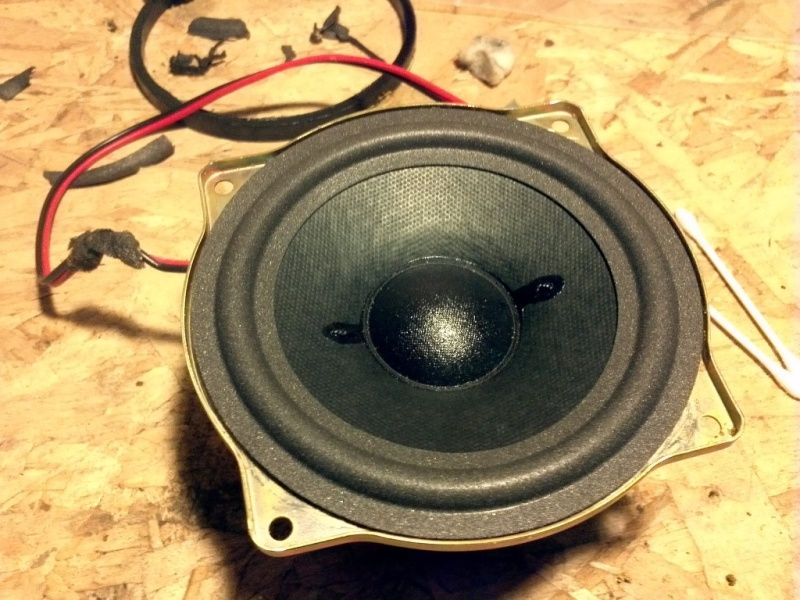
Step 7:
When you're happy with how things are looking, glue that baby down to the cone. Here a little more glue is better than too little. I found out after I used way too much, but that was ok, it cleans up easy and dries clear. I put a blob of glue on a clen piece of paper and painted it on evenly with the paint brush. You really want this to be a nice, even coat of glue. If you're using regular white glue let it sit for a couple of minutes after putting it on so it gets a bit tacky, then place the surround on, centre it and flatten the edge of the foam on the speaker with your finger. Make sure to apply light pressure everywhere around the inner edge of the surround to eliminate any air bubbles and to make sure it is fully bonded.
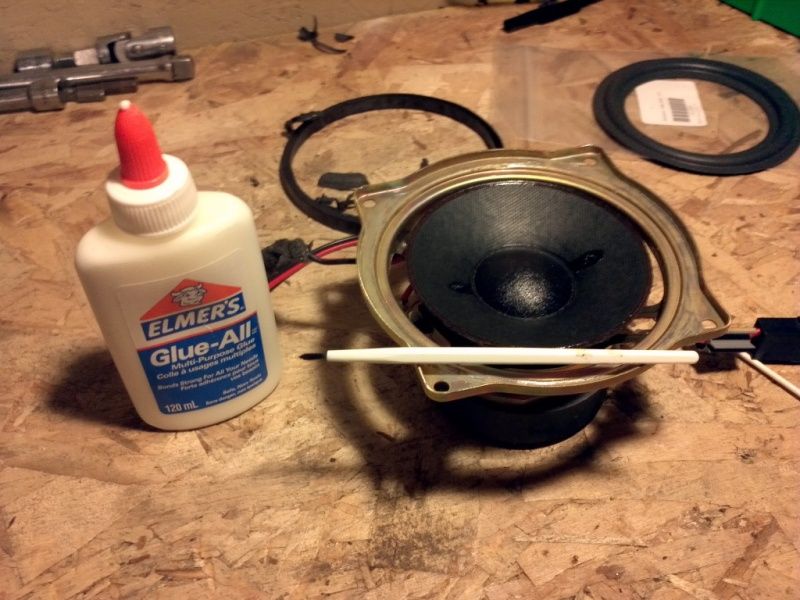
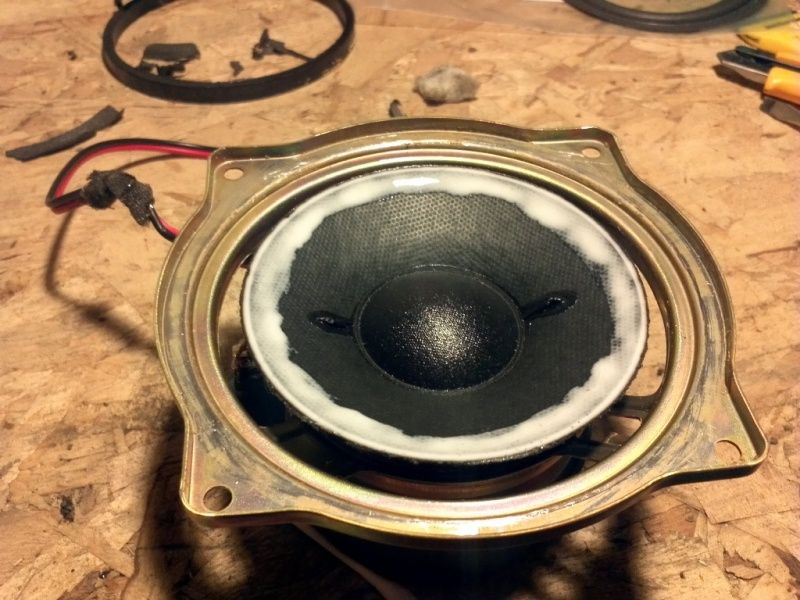
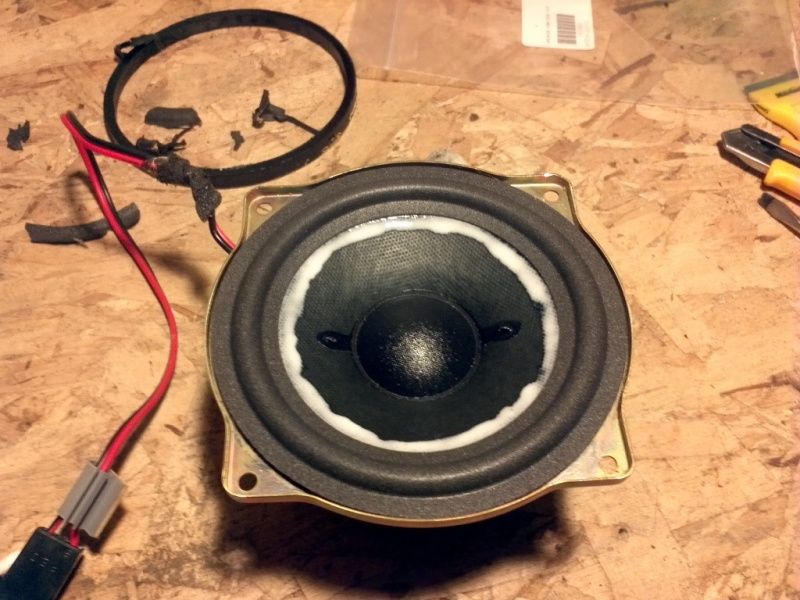
When you're happy with where it is and how it's bonding wipe away the excess glue. I used the paint brush again to scoop up the extra. Excercise the speaker again to make sure it's still moving perfectly smoothly. If it isn't you've got to fix that or it isn't going to work. It should look something like this.
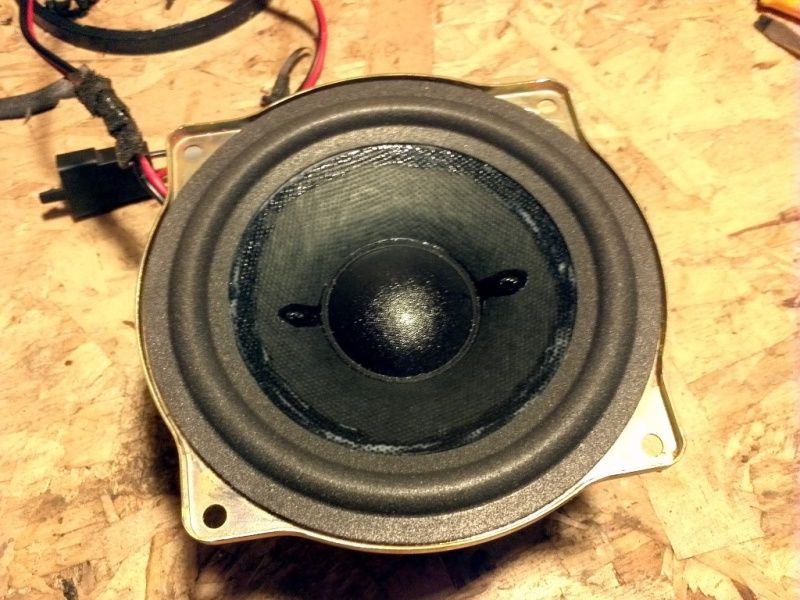
Step 8:
Do nothing until the glue adhering the foam to the cone is fully cured. I let it dry for a full 24 hours. You do not want this bond to shift or break loose when you glue the outside. After fully curing it should look something like this:
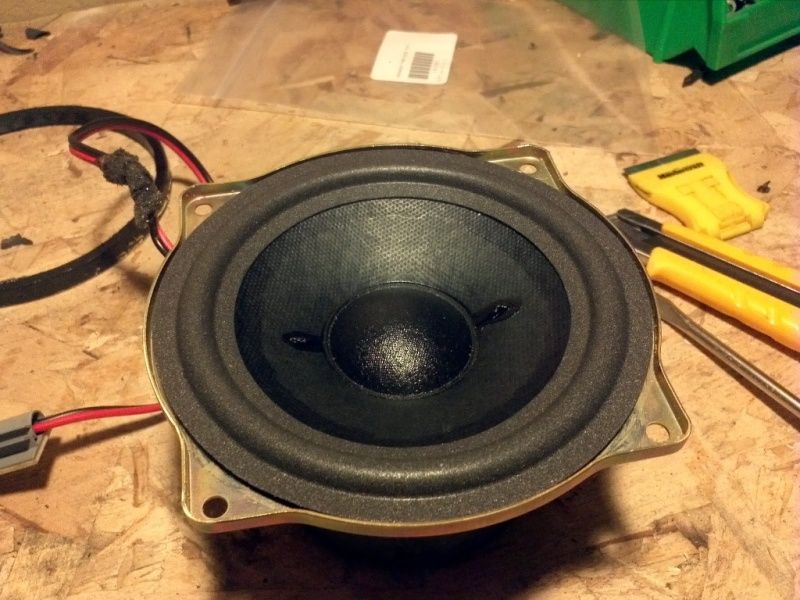
Notice how the extra glue dried clear.
Step 9:
With the cone fully cured it's time to work on the foam to frame bond. First you have to clean the plastic ring that sits on top of the frame similar to how you cleaned the frame itself. I again used my sharp knife here and wiped it with alcohol after. Again, you need to get that old speaker foam off. I also had to get some of the old glue off of it so that it would fit back in the frame smoothly. Removing old foam from the frame:
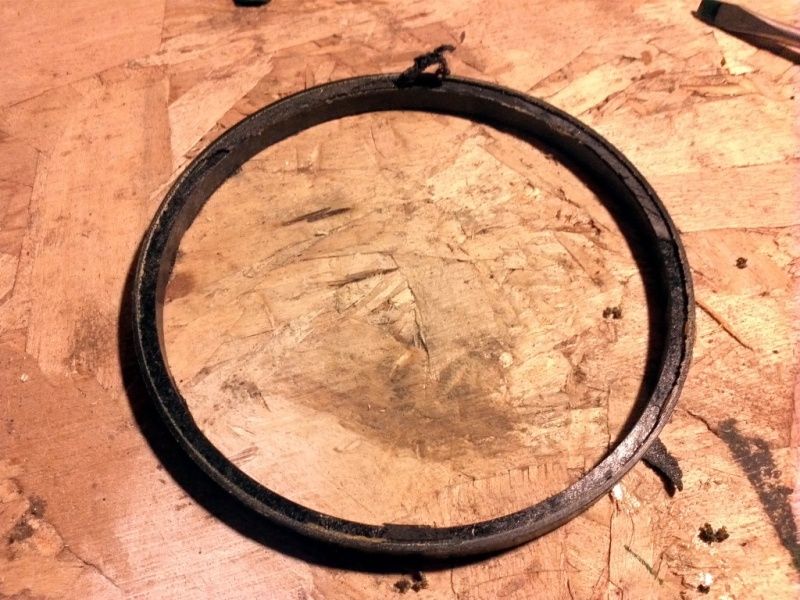
This is clean enough
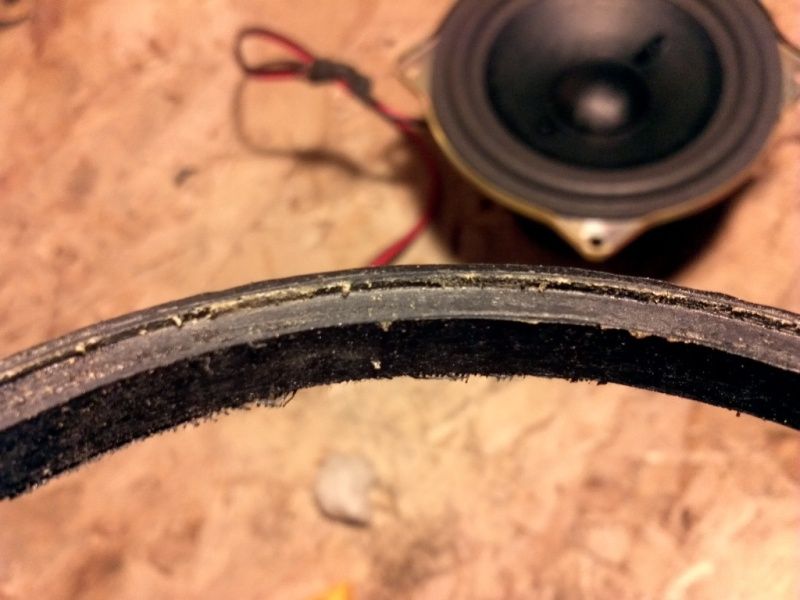
Step 10:
Glue that foam to the frame. You need to carefully lift the edge of the foam and work some glue under it onto the frame. I used my finger to do this, while applying the glue with my paint brush again. This photo is using the end of the brush to lift up the foam so my big finger wasn't blocking the view for a pic.
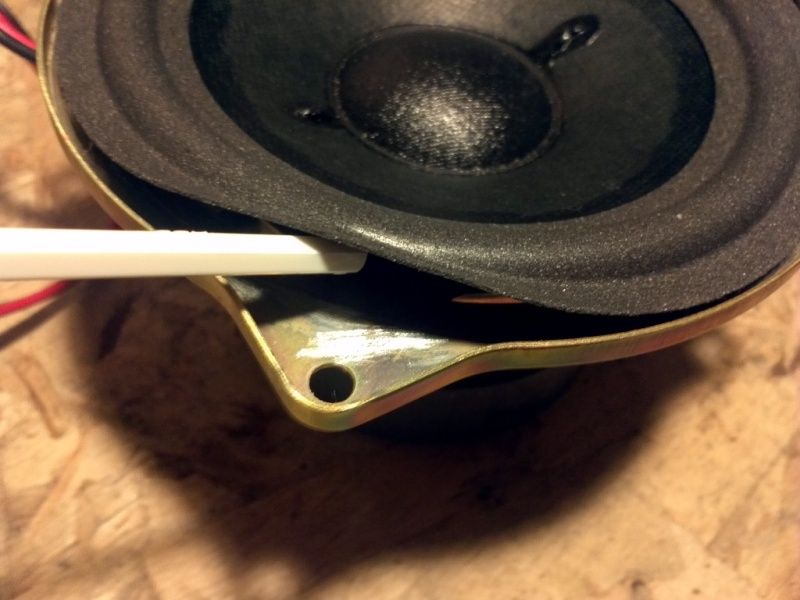
Again, let the glue set up for a few minutes and start working the outside edge down like you did on the inside. The trick here is to excercise the speaker while you're setting this to keep the cone and voice coil centred. If you feel any friction, or hear any scraping while excercising the speaker try to eliminate it by shift the cone with tiny amounts of pressure. Any time you adjust the surround you have to check and make sure that the speaker is moving smoothly here. If it isn't at this point it won't when it's dry!
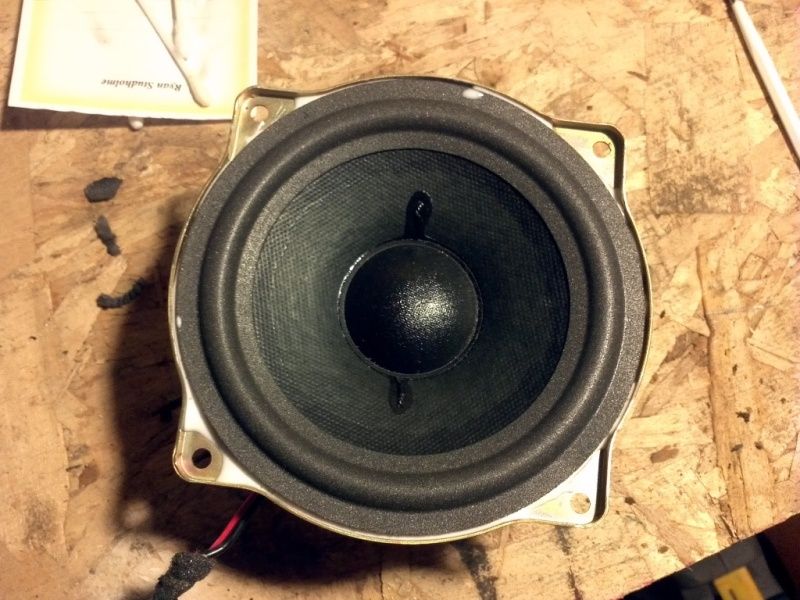
At this point due to the "springyness" of my new foam surround I had to clamp it down. It's not ideal but I had to glue down the plastic ring at the same time as gluing the foam to the frame. When installing the frame make absolute sure that you're putting it in with the lip edge down. The top of the plastic ring needs to be the smooth side to seal it properly in the enclosure. I had the speaker moving perfectly smoothly, but when I put this on I felt some light friction/scraping. Don't freakout, I was able to work thos out with very minor pressure to move the foam and ring and got it moving perfectly smooth again.
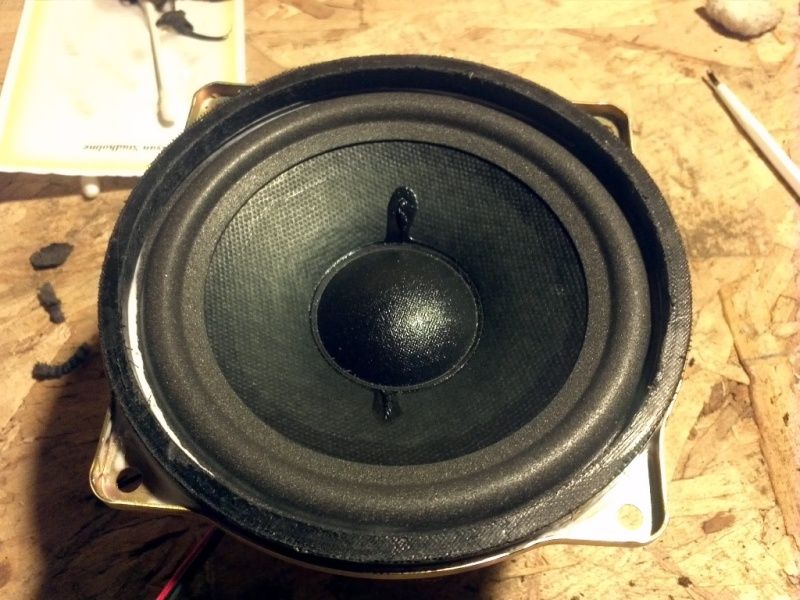
As the glue is setting stay with it and test the speaker with your fingers once in a while to make sure it stays moving freely. After my previous adjustment I was ok, but checked a few more times every few minutes to make sure it didn't pull itself back out of alignment. Here's me testing it, don't push too har or you'll go right through the speaker, and spread the pressure our so you don't compromise the cone. All I'm saying is don't jab your thumb through it on one side of the speaker.
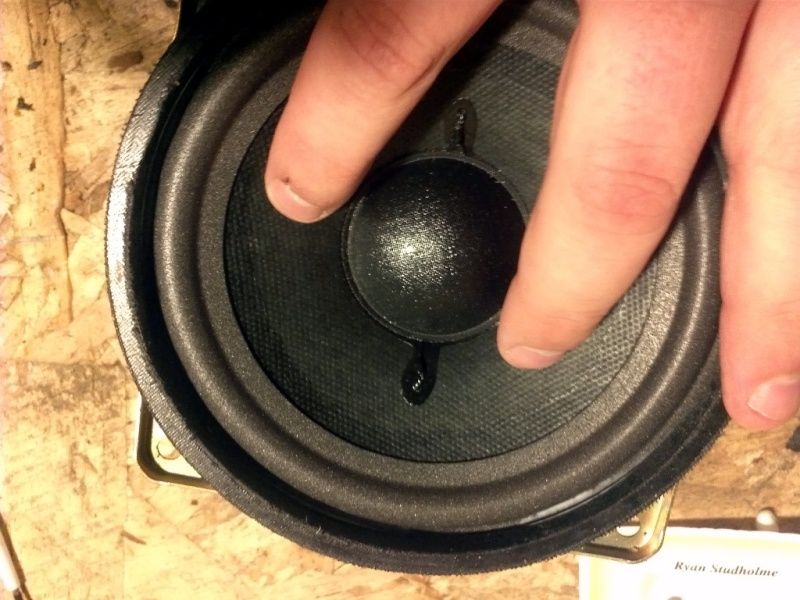
When I was happy with how it was setting up, and was comfortable that it was aligned properly I clamped it down for good. to do this I grabbed a small flat piece of wood and a can of diced tomotoes out of the pantry. Put the wood onto the speaker without shifting the plastic at all, do the same with the can of tomatoes. You can use anything that will provide even pressure onto the speaker, you don't want it tilted or anything. Also put this weight on it somewhere that you can leave it completely un-touched until the glue is dried. If you try to move it with the weight on it you will likely slide the surround (and cone) out of alignment.
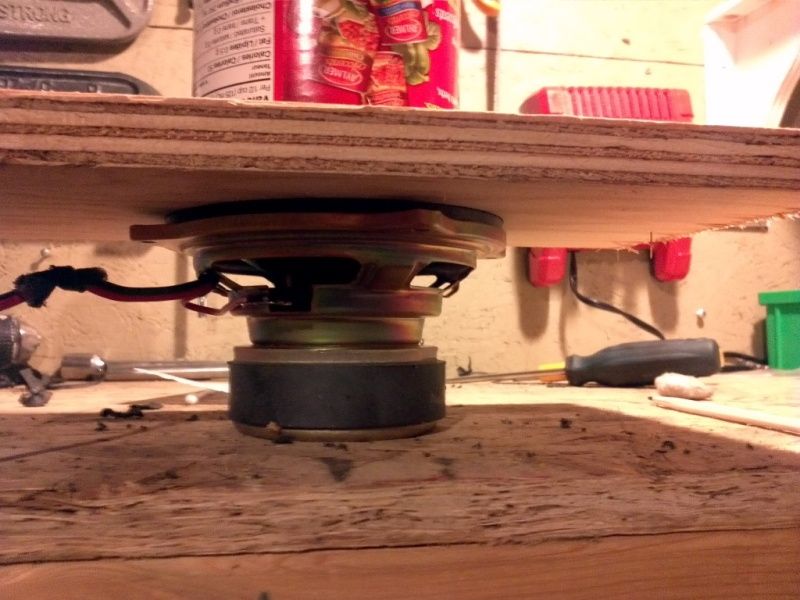
Step 11:
Check your work. If everything looks good and you can excercise the speaker without any friction or noises you've done a good job. Essentialy at this point your speaker is repaired! If you're feeling friction or hearing scraping when pushing on the cone now you will have to start over right from the beginning. This shouldn't happen if you take your time and avoid rushing.
At this point I read a tip online about re-inforcing the edges of the new foam with some more glue. I figured it couldn't hurt so I did it. apply a very small amount of glue to the edges of where the new foam meets the existing cone. This should help to stop the surround from peeling away in the future. It will also make another re-foaming job more difficult lol. With that said, if you've done it right the speaker should be good for another 20 years if you don't abuse it.
I used my finger, and rubbed some glue against the edge of the foam at the cone.

Then I used a q-tip and applied some tot he under side where the foam met the cone. This may have been a bit over-kill, but oh well.
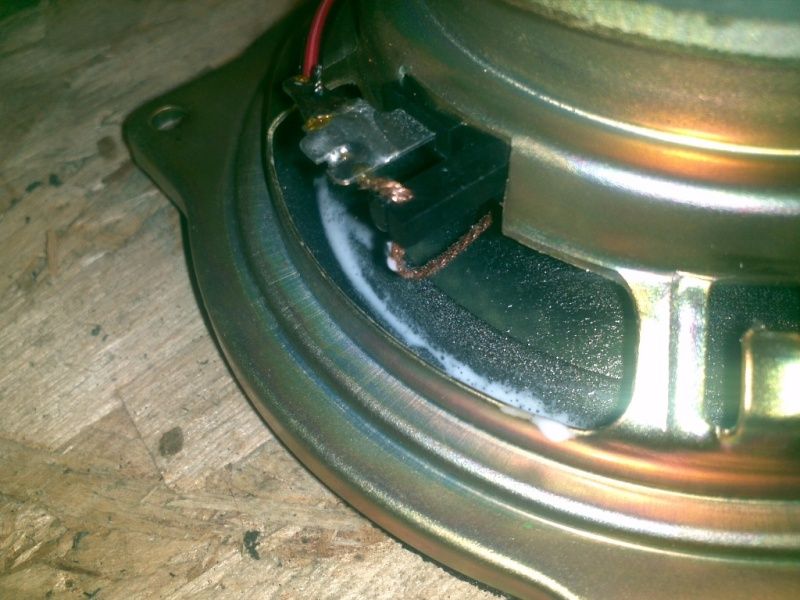
Notice I didn't remove the old foam from the bottom of the speaker. I didn't because I didn't think I could do it without damaging it, so I didn't risk it. Let this glue dry another 24 hours and the speaker is ready to go back in the car.
Step 12:
Re-assemble the sub into the enclosure exactly how you removed it. Make sure to re-use or replace all of the seals for the enclosure or it won't sound very good. Test the sub at low volume levels to make sure it's working and not making any weird sounds. When it's all good turn it up a bit to make sure it's still good. I would encourage a "break in period" before turning it up to moderate levels to let the foam loosen up a bit.
The sub with the new srround re-installed in the factory enclosure just the same as OEM with the exception of the missing grill coth.
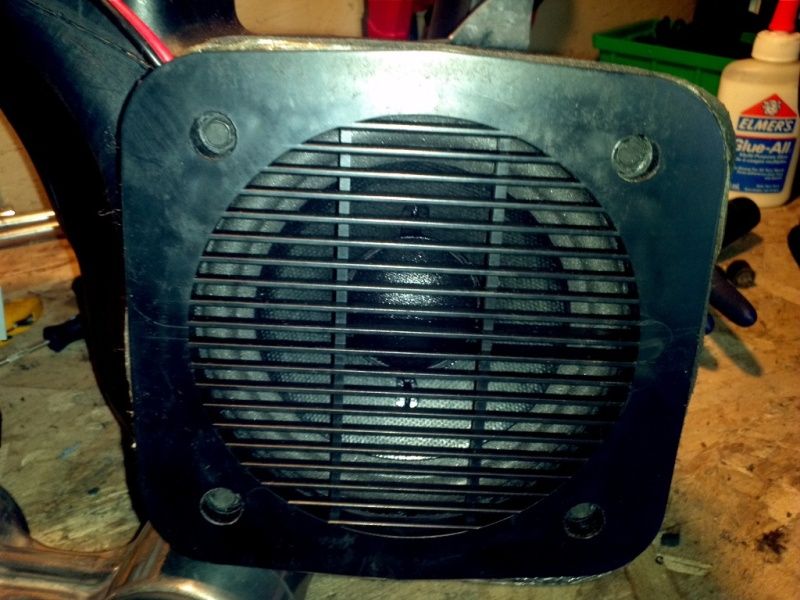
I'll tell ya it was nice to have a fully functioning stereo again, especially knowing that I fixed it myself and for what it cost me to boot. The sound is great, just like it was before it blew. Hopefully you will have as much success as I had with this repair.
Step 13:
Enjoy!






















 Now with that out of the way...
Now with that out of the way...




















